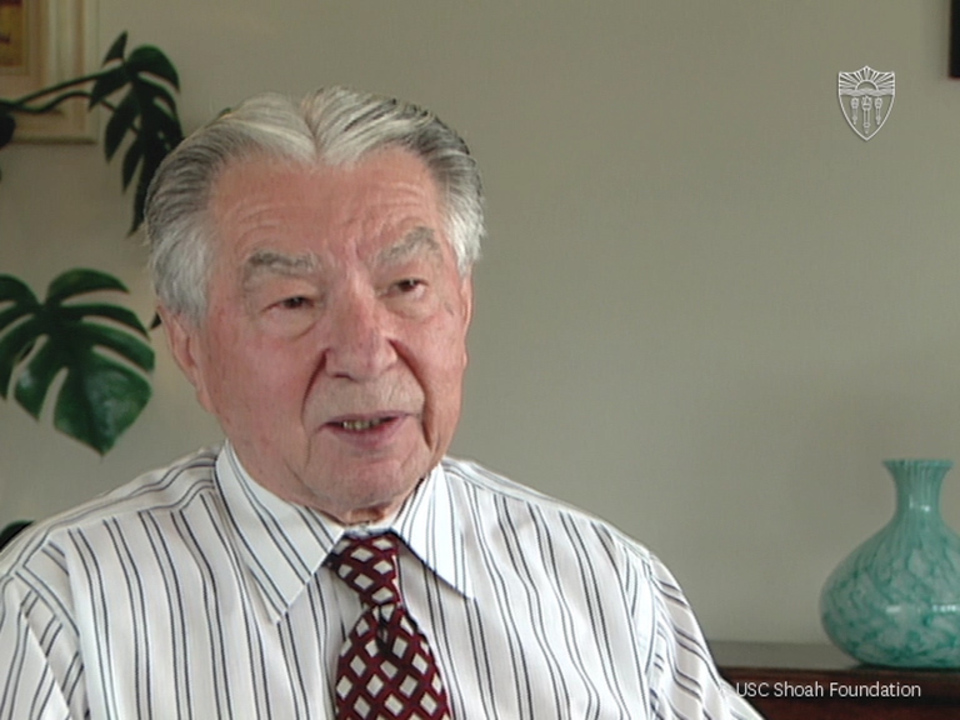Breadcrumb
- Video Witnessing Antisemitic Violence
- Video Changes at School under the Nazis
- Video From Democracy to Dictatorship
- Video Preparing for the Kindertransport
- Video Friendship and Betrayal
- Video Marched to the Ghetto
- Video Life or Death in the Netherlands
- Video Joining the Resistance
- Video Finding Safety in Italy
- Video Resistances in Auschwitz
- Video Turned Away on the M.S. St. Louis
- Video Warning the World
- Video Witness to a Massacre
- Video Eyewitness to Buchenwald
- Video Antisemitism after Liberation
- Video Reconciling Identities after the War
- Video Caring for Survivors
The Red Army Enters Majdanek
At a Glance
Language
English — USSubject
- History
- The Holocaust
The Red Army Enters Majdanek

But before we entered Lublin, we entered a real extermination camp. And this is the first sign and the first structure which we ever saw was extermination camp, Majdanek. And that was on the 23rd of July. One day later was the Majdanek. And of course, the same thing. We enter very, very carefully. We open the doors.
Was there a big gate?
There was a gate.
A big wall?
A big gate. Yes, a big gate with the wires and everything.
Barbed wires all around?
Barbed wires all around. And there were buildings. And we still didn't know it was a extermination camp. Nobody told us that.
What did you think it was?
We thought it was barracks, military barracks.
Ah, so you thought you might have German soldiers in there.
Yeah, exactly. And as a matter of fact, we did. We caught there four SS people and two Polish collaborators. And I didn't do it myself, but the other units did it. They were tried after the war. But we still did not visualize. We thought a factory, a big factory. Of course, we saw a chimney a little farther down. We saw a tremendous mound of ashes. But we still didn't know. Maybe that's a factory. Maybe it's something. Maybe that's industrial waste. Whatever it is.
And they had sorted out shoes, ladies', men's, and children's separately, completely separately. There were thousands of the shoes. And every shoe was sorted out by pair. It was sorted out and just there. One shelf after another. So that's what we saw in that thing. And there was ladies' and men's shoes. And on the side, again, we saw a big mountain of ashes, which we did not know what it was.
They had sort of like shower heads on the ceiling. We didn't know what. We thought it was water for shower. They had very small opening in the steel doors that you can see from the outside. You couldn't see anything from the inside, but you could see from the outside. They had small little opening, small windows sort of with gates on the top of the ceiling, on the side of the ceiling. And there was also looking in from on the top was also sort of like an opening. And that was the gas chambers.
They also, as far as I remember, they had benches around the edges. I don't know how many benches. I don't know exactly how many of those rooms I did see. Then after that--
But it was more than one.
It was absolutely more than one. More than one. More than three.
More than three.
Yes. Absolutely. Then after that, somebody told us what it is.
Who told you?
One of the officers came in from the outside. He already knew.
So the Polish officer had found out.
Found out, and he told us what it is.
What did he say exactly?
Well, he told us that's where people were gassed.
The Red Army Enters Majdanek
You might also be interested in…
Americans and the Holocaust: The Refugee Crisis

Teaching the Holocaust and Armenian Genocide: For California Educators

Introducing and Dissecting the Writing Prompt

Introducing Evidence Logs

Telling Our Histories

Adding to Evidence Logs, 1 of 4

Adding to Evidence Logs, 2 of 4

Adding to Evidence Logs, 3 of 4

Watching Who Will Write Our History

Adding to Evidence Logs, 4 of 4

Refining the Thesis and Finalizing Evidence Logs

Teaching Who Will Write Our History


